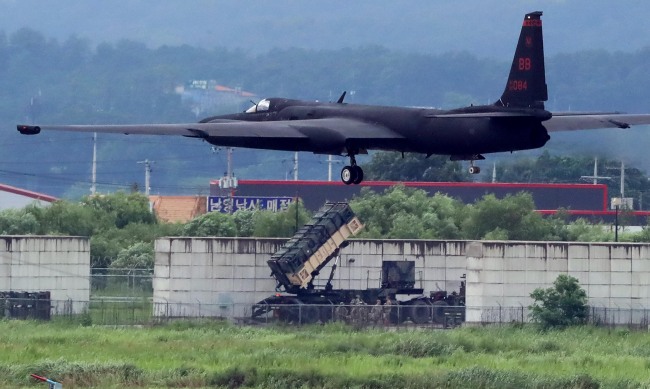S. Korea-US military drill starts amid NK missile strike concerns
By Jung Min-kyungPublished : Aug. 21, 2017 - 17:26
Concerns of a possible attack by North Korea continue to haunt the Korean Peninsula, as the Ulchi-Freedom Guardian drill kicked off Monday.
The annual South Korea-US drill is beginning as tensions rise to a new high, with Washington raising the pressure on several nations to sever ties with the hermit state.
Military tensions are expected to peak during the annual exercise after North Korea openly lambasted the drill as “the most explicit expression of hostility” against its regime, via the North’s official newspaper, Rodong Sinmun on Sunday.
The annual South Korea-US drill is beginning as tensions rise to a new high, with Washington raising the pressure on several nations to sever ties with the hermit state.
Military tensions are expected to peak during the annual exercise after North Korea openly lambasted the drill as “the most explicit expression of hostility” against its regime, via the North’s official newspaper, Rodong Sinmun on Sunday.

It added the exercise “will be like pouring gasoline on fire” and is driving the Korean Peninsula into an “uncontrollable phase of nuclear war.”
In response, President Moon Jae-in warned Pyongyang on Monday not to use the joint military exercises as a pretext for provocations, stressing the drills are “defensive in nature.”
“North Korea must understand that it is because of its repeated provocations that South Korea and the US have to conduct defensive exercises, which in turn keeps the vicious cycle going,” Moon said during a Cabinet meeting Monday.
The South Korean president also vowed to make full efforts to contain the situation, while upholding the government’s two-track approach of dialogue and sanctions against the North.
Moon had previously attended a National Security Council meeting at 9 a.m. on Monday with Prime Minister Lee Nak-yon and several senior government officials to discuss plans related to the joint exercise and defense against possible North Korean provocations.
But the Pentagon announced that this year’s UFG drill will involve fewer American troops -- about 17,500, down from last year’s 25,000.
US Defense Secretary James Mattis explained the reduction is due to the current focus on integration operations and a requirement for fewer people, and that it is not due to tensions with North Korea.
In recent years, North Korea has displayed military provocations around the joint exercise period. Pyongyang fired a submarine-based ballistic missile last year and shot antiaircraft guns at an anti-North Korea propaganda loudspeaker unit near the inter-Korean border in 2015.
Meanwhile, the ruling Democratic Party of Korea renewed calls for Pyongyang to accept Seoul’s offer to open dialogue.
“North Korea should accept (the reduced level of US troops) as a signal for a North Korea-US dialogue channel,” Rep. Choo Mi-ae, the leader of the Democratic Party, said during a meeting with senior party members Monday.
“I also hope the North will not make a reckless decision to engage in another provocative act by misjudging the situation,” she added.
While the joint exercises are being carried out here, Washington is expected to stick to its agenda of convincing the global community to use their diplomatic and economic clout in bringing about Pyongyang’s denuclearization.
The Donald Trump administration called on South American countries such as Chile, Brazil, Mexico and Peru to cut off diplomatic and trade ties with North Korea last week.
“The era of strategic patience is over with regard to North Korea. All options are on the table,” US Vice President Mike Pence said, following his meeting with Chilean President Michelle Bachelet on Thursday.
Chile exported $2 million worth of products to North Korea in 2015, of which 90 percent was copper, while importing $25 million, largely in steel and iron products, said Bloomberg, citing Chilean media.
The US has been ratcheting up pressure on China to use Pyongyang’s reliance on the world’s second largest economy as means to cut off funds for the North’s nuclear and missile development.
The growing worries here also involve the US’ tightening efforts to intervene in North Korea’s diplomatic relations, which may trigger further anger from North Korea.
“There is a high chance of the North conducting military provocation around this time,” Lee Woo-young, a professor at the University of North Korean Studies, told The Korea Herald.
“It seems the US is trying to induce a response from the North through contacting the South American nations. ... But it is crucial to be cautious and aware of the consequences of those actions.”
By Jung Min-kyung (mkjung@heraldcorp.com)


![[Exclusive] Korean military set to ban iPhones over 'security' concerns](http://res.heraldm.com/phpwas/restmb_idxmake.php?idx=644&simg=/content/image/2024/04/23/20240423050599_0.jpg&u=20240423183955)




![[Pressure points] Leggings in public: Fashion statement or social faux pas?](http://res.heraldm.com/phpwas/restmb_idxmake.php?idx=644&simg=/content/image/2024/04/23/20240423050669_0.jpg&u=)

![[Herald Interview] 'Amid aging population, Korea to invite more young professionals from overseas'](http://res.heraldm.com/phpwas/restmb_idxmake.php?idx=644&simg=/content/image/2024/04/24/20240424050844_0.jpg&u=20240424200058)









